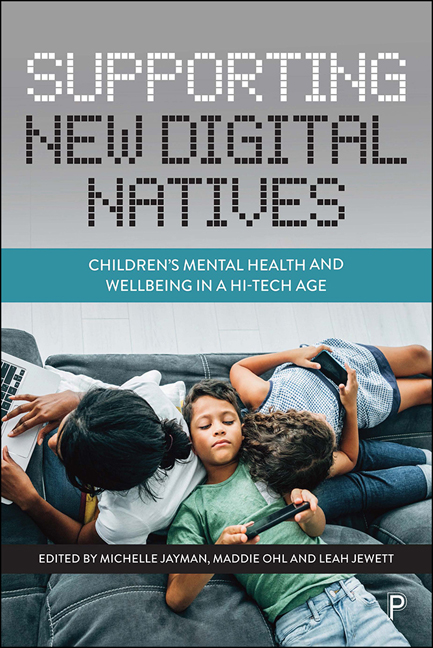Book contents
- Frontmatter
- Dedication
- Contents
- List of figures and tables
- Glossary
- Notes on contributors
- Foreword
- Preface
- 1 Digital lives: growing up in a hi-tech world and staying mentally healthy
- 2 Pyramid Club: building skills for healthy friendships and relationships in a digital age
- 3 Supporting children’s healthy socio-emotional development through play: Book of Beasties – the mental wellness card game
- 4 The School Counselling Partnership: providing support and promoting self-care for school communities
- 5 The Breeze Project: supporting children and young people through Forest School
- 6 Promoting the mental health of girls and young women in the community: the role of Girlguiding
- 7 Supporting families to navigate the changing sex-education landscape: Outspoken Sex Ed
- 8 The Lift Off programme by Red Balloon: online learning and wellbeing support for children who self-exclude from school
- 9 The LifeMosaic project: supporting wellbeing and empowering pupils through design, development and research
- 10 Building better mental wellbeing for children: rebel thinking and innovative practice
- Index
9 - The LifeMosaic project: supporting wellbeing and empowering pupils through design, development and research
Published online by Cambridge University Press: 13 May 2022
- Frontmatter
- Dedication
- Contents
- List of figures and tables
- Glossary
- Notes on contributors
- Foreword
- Preface
- 1 Digital lives: growing up in a hi-tech world and staying mentally healthy
- 2 Pyramid Club: building skills for healthy friendships and relationships in a digital age
- 3 Supporting children’s healthy socio-emotional development through play: Book of Beasties – the mental wellness card game
- 4 The School Counselling Partnership: providing support and promoting self-care for school communities
- 5 The Breeze Project: supporting children and young people through Forest School
- 6 Promoting the mental health of girls and young women in the community: the role of Girlguiding
- 7 Supporting families to navigate the changing sex-education landscape: Outspoken Sex Ed
- 8 The Lift Off programme by Red Balloon: online learning and wellbeing support for children who self-exclude from school
- 9 The LifeMosaic project: supporting wellbeing and empowering pupils through design, development and research
- 10 Building better mental wellbeing for children: rebel thinking and innovative practice
- Index
Summary
Technology and children’s agency in a digital age
The nature of childhood and adolescence is characteristically social, complex and in constant flux. This is further intensified for new digital natives (NDNs) by the ubiquity of digital technologies which shape their unique, rapidly changing experiences. While there are myriad possibilities for digital technologies to be utilised in supporting the mental and physical wellbeing of children, it would be over-simplistic to consider such technologies in an exclusively instrumental light. Harnessing these opportunities requires some understanding of how digital technologies work and the ways in which children perceive and use them. Sakr (2020) adopts the term ‘affordances’ to describe the physical properties and social associations of any tool children use to learn and play, digital or otherwise. In this sense, affordances refer not only to an object’s physical potential but also to the social and cultural messages which define appropriate forms of engagement. As Sakr (2020) and others (for example Ruckenstein, 2013) suggest, a socio-cultural perspective can help our understanding of how digital activities are mediated by social, cultural and material contexts.
Human agency involves volition and intentionally making things happen by one’s actions – for Bandura (2001) this involves evaluating socio-cultural opportunities and constraints and regulating behaviour accordingly. Human agency inevitably influences the interface between digital technologies and learning outcomes; however, within formal education settings, structures and rules dictate what adults and children can actually do. Hierarchical teacher–pupil power relations still commonly prevail in classrooms in the United Kingdom, and varying constraints exist in terms of how digital technologies are taken up within local educational contexts. Structure and agency are thus intricately entwined. Agency is a central component of the constructivist theories that position learners as active and productive agents (Kucirkova, 2019). Children’s agency becomes manifest through resources, such as digital technologies, and activities, such as design and research, which support children’s own choices, motivations and independence (Vygotsky, 1997). This chapter considers how a collaborative partnership between pupils and their teacher harnessed technology to support children’s wellbeing through an innovative digital design project which placed children’s agency at its core. LifeMosaic is a personal informatics (PI) wellbeing app designed, developed and evaluated by members of the youth population it aims to support.
- Type
- Chapter
- Information
- Supporting New Digital NativesChildren's Mental Health and Wellbeing in a Hi-Tech Age, pp. 156 - 174Publisher: Bristol University PressPrint publication year: 2021

